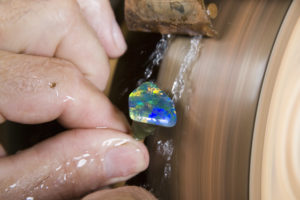FAQ : How do I take care of opals? What is the best way of caring for opal? What is a doublet? What is a triplet? How do I clean my opal? What happens if I get my opal wet?
Because we love opal, we like to educate our customers on how best to care for their opals, so they can enjoy the beauty of this individual and precious gemstone for many years to come. Please take a few moments to read this guide, and don’t hesitate to email us if you have any questions.
Doublets, Triplets, & Solid Opal
Taking care of opal is easy. All it takes is a little bit of common sense and knowledge about opal. Before deciding how to best care for your opal you need to be aware of the type of opal you have;
- Doublets – Doublet opals consist of two layers, a thin slice of opal and a black backing. The slice of opal is cemented to the backing in order to enhance the colour.
- Triplets – Similar to doublets, triplets also include a third transparent layer on the top (quartz or glass) to protect the opal and give it a rounder shape.
- Solid Opal – Natural solid opal which has only been cut and polished.

Caring for your Opal
Solid Opals – Opal is a soft stone, approximately the same hardness as glass (around 6.5 on Moh’s hardness scale), so it is important to treat your opal carefully in order to avoid damaging it. Remove your opal jewellery if there is a chance it will be scratched or broken (i.e. working in the garden, moving furniture, etc.)
Many people believe solid opals can be damaged by water – however, this only applies to doublets and triplets. Solid opals are fine in water. In fact, most precious opals contain about 5-6% water. As a result, opal may crack if subjected to very dry conditions or rapid changes in temperature. Try to avoid very high temperatures or low humidity extremes, such as boiling water or zero humidity bank vaults.
Doublets & Triplets – Caring for doublets or triplets is a little different to caring for solid opals. Because doublets and triplets consist of multiple layers glued together, prolonged exposure to water will eventually cause lifting between the layers and the infiltration of water. A doublet or triplet will take on a ‘foggy’ or grey appearance if this happens. This does not mean your opal will be ruined if you wear it in the shower once, or are caught in the rain. It takes prolonged exposure to cause water damage to a doublet or triplet.
Cleaning Your Opal
Solid opal should be cleaned gently with mild detergent in warm water and a soft toothbrush or cloth. Avoid bleach, chemicals and cleaners. Doublets & triplets may be wiped with a damp soft cloth and mild detergent, but should never be soaked or immersed.
Never allow anyone to clean your opal in an ultrasonic cleaner, as the intense vibrations may cause cracking in a solid opal, and water penetration in a doublet or triplet.
If your stone loses its shine or becomes scratched, bring it back to an opal cutter. After years of wear, small scratches and scuff marks cause an opal to lose its shiny polish and become dull looking. Professional polishing can bring new life to an opal which has become dull or scratched, and we can also check for claw damage and ensure the security of the setting.
Storing Opals
If you need to store your opal away for a period of time, simply place it in a padded cloth bag for protection and store it away. For longer storage periods, place your opal in cotton wool with a few drops of water, then into a sealed plastic bag just to be safe. The water is not intended to soak into the stone (as opal is impervious) but will prevent water coming out of the stone if it is exposed to very low humidity environments (for example, zero humidity storage safes).
We hope this guide has been helpful to you, feel free to contact us if you have any further questions… Take care!


